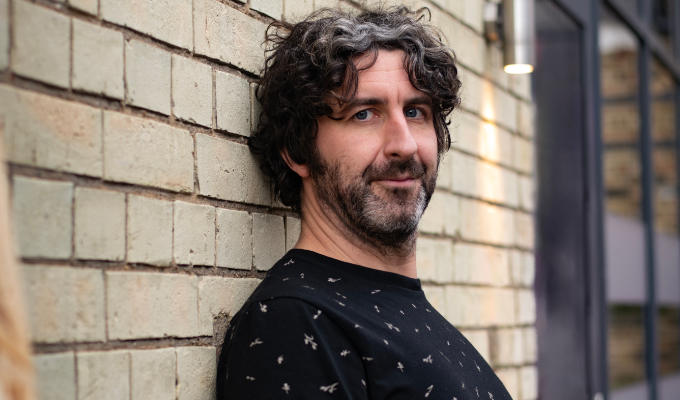Stewart Lee, master of the insects
Final extract from his new book
Here, in our final extract from his book How I Escaped My Certain Fate, Stewart is describing his idea to perform as an insect, costume and all, after being asked to appear at Pestival, an annual gathering of entomologists.
I think, looking at it now, that like many things in my shows, this insect idea also has its roots in a conversation with Simon Munnery.
For one of the Cluub Zarathustra cabaret shows, Simon had come up with the idea of an insect comedian of some sort. There was a precedent for this in his work. During the Edinburgh Fringe in 1990, I had helped Simon experiment in an onstage collaboration with a worm by driving him to Mike’s Tackle Shop in Musselburgh, where all kinds of worms were commercially available in large quantities.
As Simon’s proposed act involved the worm being publicly slain, I overcame my ethical opposition to this by suggesting that rather than being dug up from the Scottish earth, the worm should be purchased from somewhere where it would otherwise have been sold to a fisherman, who would only have impaled it on a hook and fed it to a fish anyway. Normally, I don’t think I could have countenanced assisting someone in slaughtering a worm in the name of entertainment, but I had recently read Hemingway’s persuasive 1929 book on bullfighting, Death in the Afternoon.
In Death in the Afternoon, Hemingway convinces the reader that the artistry of the bullfight is so great that we can spare a few bulls and discount their pain. As a toddler I remember being taken to a bullfight in Spain by my mother and amusing the locals by cheering for the bull to kill the man, and I put a load of slides my father had taken of the event down the toilet in protest, but Death in the Afternoon swung me, albeit temporarily. And I was convinced that whatever the comedy genius Simon Munnery had in mind for the worm, it would at least be the match of the artistry of the capering Spanish butchers. And certainly, the tiny hangman’s gibbet that he was constructing out of balsa wood in our flea-infested Edinburgh flat was a work of art in itself.
Simon was booked into the Fringe Club that night, a massive space in the student-union building. Back when the Fringe was run on dole cheques and goodwill, before the money men moved in, the Fringe Club offered free showers, free poster space and free nightly entertainment to masses of ungrateful people drunk on subsidized booze. Simon took the stage in the persona of The League Against Tedium, a top-hatted dictator character given to highly quotable and unforgettable aphorisms, usually about his superiority to all other living things, and a kind of right-wing mirror image of his earlier Alan Parker Urban Warrior incarnation. I don’t remember it going especially well that night, but by the end of Simon’s allotted time his failure was sealed.
In an attempt to display his superiority to worms, The League Against Tedium took the worm and tied it with cotton to the gibbet, which was set on a table front-lit by a powerful lamp that back-projected the shadow of the worm’s wriggling body 30ft high onto the rear wall of the venue. Then, to a cacophony of boos and jeers, and the sound of women bursting into tears, The League Against Tedium took a pair of scissors and ceremoniously snipped the worm in two, the half of its body that remained tied to the worm-gibbet jerking spasmodically in confusion and discomfort.
Hemingway convinced me that bullfighting was worth a few worms. But as he exited through the back entrance of the building, to escape a crowd baying for his blood, Simon Munnery had not convinced me that he was worth even one worm.
For the Cluub Zarathustra insect act, five years later, Simon suggested putting an insect in a tank and pretending it was a comedian, though at no point was killing it in public ever discussed. I thought the insect should be as big an insect as possible, like a stick insect or a praying mantis, and that it should have some kind of mini-microphone stand in the case. Simon wanted to get the comedian Jeff Green to voice the insect’s act from offstage, whilst a camera relayed footage of the insect onto a big overhead screen.
Jeff’s act at the time was composed of good-natured laddish bits on everyday experience. I think Simon just wanted Jeff to do his actual act, and for that to be the stand-up act of an insect, whereas I wanted to write something like the act I ended up doing here in 41st Best Comedian. But we both agreed that for some reason, Jeff Green’s voice, a high and keening Scouse falsetto which was instantly likeable, would be the ideal voice for the tiny insect comedian.
Well, of course, like so many things, this never came to anything, but there are morphic resonances of it throughout British comedy ever since, of which my own attempt at observational insect stand-up is but one. My wife Bridget Christie, entirely unaware of the Jeff Green/Stick Insect idea, has recently been appearing around London in a home-made ant costume – not onstage, though – just for her own amusement. And when I was script-editing Harry Hill’s shows for Channel 4 in the late Nineties, the floppy-collared loon™ became fascinated by the comic possibilities of flies, filling miniature television studios, sealed inside Perspex tanks, with hundreds of them, specially bred from sacks of maggots which were delivered at the start of shooting.
I contacted Harry through his spokesman to ask him for his memories of the fly skits, and this was the reply I received: ‘The fly thing is a while ago but I believe it to be my idea. The first one was The Fly Cruise and we also did Play Your Cards Right. I can’t really remember. I think we did about five and that Al Murray did the buzzing noises of the flies.
‘The flies were supplied by an animal wrangler who had to get the maggots at the right stage to hatch in time for the show. Although the mini sets were filmed under Perspex boxes inevitably a lot of the flies got out and then turned up on the set for the recording of the stand-up sections of the show which led to many retakes being needed.’
Thanks, Harry!
It was the job of our director, the old-school BBC bow-tie-and-moustache man Robin Nash, to try and film convincing light-entertainment-style footage of the massed flies. Robin was mentioned earlier in this book, as it was he who insisted on splitting Queen’s ‘Bohemian Rhapsody’ into two parts when he produced Top of the Pops because he thought it too long for television. Perhaps Nash was being punished by the ghost of Freddie Mercury, now an actual lord of the flies with power over insect life, by being made to film his unruly subjects.
For the fly sketches it was difficult for Robin, even with many years of experience filming Pan’s People and Legs & Co., to get what we television professionals call ‘singles’, which are shots of performers in isolation from their fellow actors. The flies had proven resistant to direction, and many of them had died and were just lying in a heap. To this day I remember Robin standing in the gallery and tearing his hair out in rage as he bellowed to the camera operators on the studio floor, ‘No, on his face! On the fly’s face!!’
TV’s Harry Hill takes up the tale: ‘I too remember Robin shouting “No! On the fly’s face!” And also, one of the first things I ever saw at the Edinburgh Fringe festival was Simon Munnery at the Fringe Club cutting a worm in half and I remember being quite shocked by it. I think he was booed off. That same night I saw one of my future managers heckling an Asian woman in a wheelchair by shouting “Sad fuck!” It was the year of Newman and Baddiel. All the flies are dead now.
Warming to his insect theme, Harry continues: ‘I recently resurrected the fly thing and did insect EastEnders on TV Burp, my multi-award-winning ITV show. It was a proud moment – an all-insect-acted sketch on ITV prime time. Oh my! If you’d told me that I would be doing that 30 years ago when I originally thought of insect-acted sketches I would have collapsed in a big old heap of laughter.
Dear readers, despite it mentioning Hemingway and describing the execution of a worm, this footnote has been the most showbiz section of this book so far. I bet you liked it.
- Stewart Lee's How I Escaped My Certain Fate is published by Faber & Faber on Thursday, priced £12.99. Click here to buy it from Amazon for £7.99
- Click here to read the previous passage about Lee becoming an alternative comedian, and here for the extract on the origins of a joke about Joe Pasquale.
Published: 2 Aug 2010






